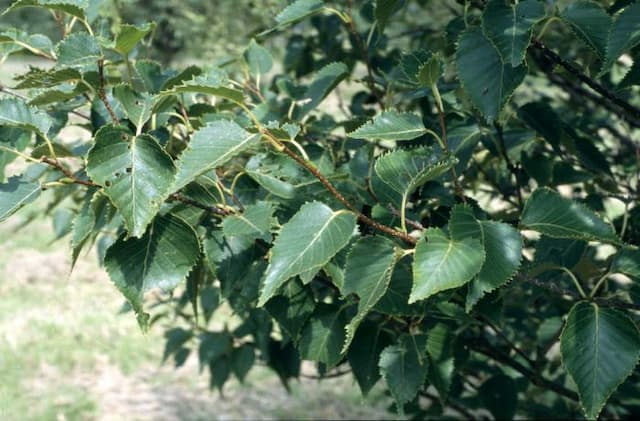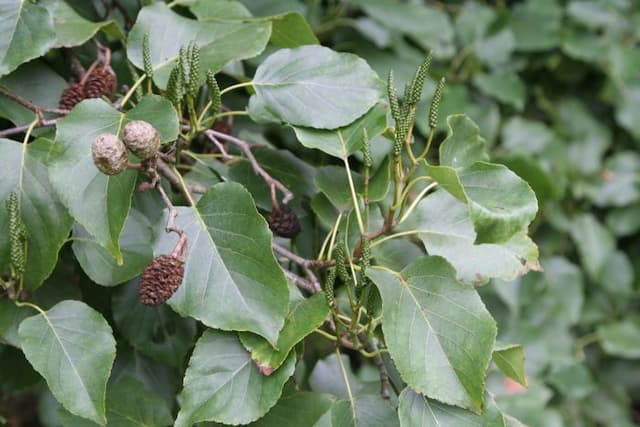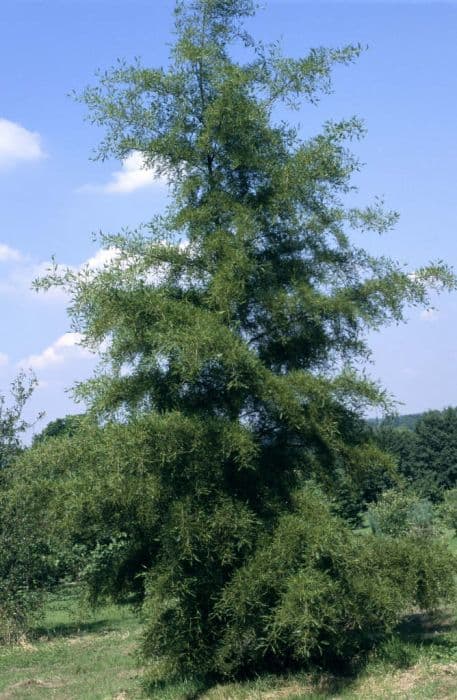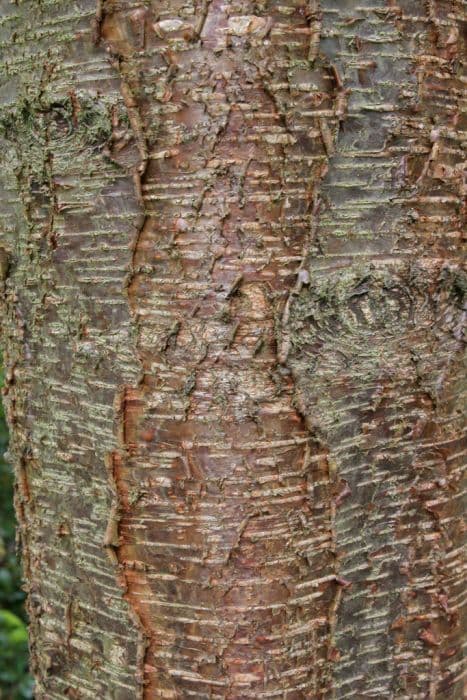Himalayan Birch Betula utilis subsp. jacquemontii 'Grayswood Ghost'

ABOUT
The Himalayan birch 'Grayswood Ghost' is widely recognized for its strikingly beautiful bark. It boasts a brilliant white bark that is both smooth and eye-catching, a characteristic that makes it particularly popular in gardens for its ornamental value. In contrast to its bark, the leaves exhibit a rich green hue, further accentuating the tree's visual appeal. These leaves are shaped with a distinctive oval form and possess a subtle serrated edge, which becomes a golden yellow as the cooler months arrive, heralding the change of seasons. The tree produces catkins, which are long and cylindrical flower clusters, typical of birch trees, that impart additional visual interest. Overall, the 'Grayswood Ghost' variant of the Himalayan birch is chosen for the impressive contrast between its luminous bark and lush foliage, providing year-round interest in various landscapes.
About this plant
 Names
NamesFamily
Betulaceae
Synonyms
Himalayan Birch, White-Barked Himalayan Birch, Silver Shadow, Grayswood Ghost
Common names
Betula utilis var. jacquemontii, Betula jacquemontii.
 Toxicity
ToxicityTo humans
Himalayan birch is not known to be toxic to humans. There are no common reports of poisoning or toxic effects from ingesting or handling the tree. Consequently, there are no specific poisoning symptoms associated with the Himalayan birch. However, like with any plant material, individuals may have allergic reactions or sensitivities, so caution should be exercised.
To pets
Himalayan birch is not known to be toxic to pets. It is not commonly associated with poisoning in cats, dogs, or other domestic animals. Therefore, there are no specific symptoms of poisoning that are expected if pets ingest parts of the Himalayan birch. Nonetheless, it's always a good idea to prevent pets from consuming plant material, as it can sometimes cause gastrointestinal upset or allergic reactions.
 Characteristics
CharacteristicsLife cycle
Perennials
Foliage type
Deciduous
Color of leaves
Green
Height
30 feet (9 meters)
Spread
20 feet (6 meters)
Plant type
Tree
Hardiness zones
7
Native area
Himalayas
Benefits
 General Benefits
General Benefits- Ornamental Value: 'Grayswood Ghost' is a highly ornamental birch with striking white bark that provides year-round interest, especially in winter landscapes.
- Wildlife Habitat: It offers habitat and food for birds and other wildlife, as its catkins are a food source for birds in early spring.
- Shade Provider: Like other birches, 'Grayswood Ghost' can provide ample shade in garden settings, making outdoor spaces more enjoyable during hot weather.
- Drought Tolerance: Once established, it has a good level of drought tolerance, requiring less maintenance in terms of irrigation.
- Soil Improvement: As a deciduous tree, it contributes to soil health through leaf litter, which decomposes and enriches the soil with organic matter.
- Erosion Control: Its root system can help stabilize soil and control erosion on slopes or banks.
- Adaptability: 'Grayswood Ghost' is adaptable to a variety of soil types, although it prefers moist, well-drained conditions.
- Climate Resilience: Being a hardy plant, it has the ability to withstand cold temperatures, making it suitable for many temperate climates.
 Medical Properties
Medical PropertiesThis plant is not used for medical purposes.
 Air-purifying Qualities
Air-purifying QualitiesThis plant is not specifically known for air purifying qualities.
 Other Uses
Other Uses- Landscaping: Himalayan birch, with its striking white bark and elegant stature, is often used in landscapes to serve as a focal point, especially in winter gardens where its bark stands out against the backdrop of dormant plants.
- Photography: The distinct bark of 'Grayswood Ghost' provides a unique texture and contrast, making it a popular subject for garden photographers and a backdrop for outdoor portraiture.
- Environmental Education: This plant is used in schools and educational programs to demonstrate tree bark variations and adaptation to environments.
- Art Supplies: Small branches and twigs can be used for crafting and as natural elements in art projects such as homemade wreaths or as a canvas for bark painting.
- Eco-friendly Dyes: The bark can be boiled to extract natural dyes for fabrics or paper, offering a sustainable alternative to synthetic dyes.
- Theme Gardens: 'Grayswood Ghost' can be included in moon gardens, which are designed to be enjoyed at night, as its pale bark reflects moonlight beautifully.
- Wildlife Shelter: The tree can offer refuge and nesting sites for various birds and small mammals within its branches.
- Seasonal Decorations: Branches and leaves can be used in fall and winter decorations, providing a natural and seasonal element to home decor.
- Cultural Significance: In some cultures, the birch tree holds symbolic meaning and is incorporated into festivals and ceremonies as a representation of new beginnings or cleansing.
- Habitat Restoration: Can be planted as part of reforestation efforts and to enhance the biodiversity of an area, which is part of ecological conservation programs.
Interesting Facts
 Feng Shui
Feng ShuiThe Himalayan Birch is not used in Feng Shui practice.
 Zodiac Sign Compitability
Zodiac Sign CompitabilityThe Himalayan Birch is not used in astrology practice.
 Plant Symbolism
Plant Symbolism- Adaptability - Betula utilis, commonly known as Himalayan birch, often grows in tough mountainous climates, symbolizing an ability to thrive in challenging conditions.
- Purity - The 'Grayswood Ghost' variety, with its striking white bark, is often associated with purity and cleanliness.
- New Beginnings - Birch trees are known to be pioneering species that repopulate landscapes after disturbances, representing new starts or rebirth.
- Protection - In various cultures, birch trees are thought to ward off evil and are used as protective talismans.
- Renewal - The shedding of the Himalayan birch's bark can represent personal growth and the shedding of the old to make way for new growth and renewal.
 Water
WaterThe Himalayan Birch or 'Grayswood Ghost' should be watered with a deep and thorough soaking, ensuring that the water penetrates several inches into the soil to reach the tree’s root system. Young trees benefit from watering once a week, while established trees can be watered every two to three weeks, with an increase during periods of drought or extreme heat. During the growing season, the water requirement is typically about 10 gallons per week for a young tree. Adjust the amount as necessary for the tree's size and the local weather conditions, making sure not to waterlog the soil which could lead to root rot.
 Light
LightHimalayan Birch thrives best in full sunlight, where it can receive at least six hours of direct, unfiltered sunlight each day. It's essential to plant it in a spot that is not overshadowed by taller trees or buildings to ensure it gets the maximum amount of light throughout the day. This tree can also tolerate partial shade, but its white bark is most striking when illuminated in full sun.
 Temperature
TemperatureThe Himalayan Birch is best suited for cooler climates, tolerating temperatures as low as -20°F and up to about 80°F. It is most comfortable in temperatures ranging between 50°F and 70°F. It's important to provide some protection from harsh winter winds, which could damage the branches and bark.
 Pruning
PruningPruning a Himalayan Birch is typically done to remove dead or diseased branches and to shape the tree for aesthetic purposes. The best time to prune is late winter or early spring before new leaves appear. To encourage healthy growth, prune every 3 to 5 years, concentrating on maintaining the tree's natural form and removing any branches that cross or rub against each other.
 Cleaning
CleaningAs needed
 Soil
SoilThe Himalayan birch or White-barked Himalayan birch prefers well-draining soil with a mixture of loam, sand, and organic matter. A slightly acidic to neutral pH of 5.5 to 7.5 is ideal for its growth. Amend the soil with compost before planting to ensure nutrient-rich conditions.
 Repotting
RepottingThe Himalayan birch, being a large tree, is not typically repotted as it is usually planted directly in the ground. However, if started in a container, it should only be repotted when it has outgrown its current one, which may not be frequent due to its size.
 Humidity & Misting
Humidity & MistingThe Himalayan birch thrives in average humidity conditions. As a tree accustomed to temperate climates, it does not require unusually high humidity levels and can tolerate the humidity found in most outdoor environments.
 Suitable locations
Suitable locationsIndoor
Planting Himalayan birch indoors is not viable.
Outdoor
Full sun, moist, well-drained soil, space to grow.
Hardiness zone
5-7 USDA
 Life cycle
Life cycle'Grayswood Ghost', commonly known as Himalayan birch, begins its life cycle when a seed germinates in spring or early summer after a period of cold stratification. The seedling emerges and establishes itself, growing a taproot and beginning to develop foliage. As a young sapling, 'Grayswood Ghost' enters a rapid growth phase, with its distinctive white bark becoming apparent as it matures. During its adult phase, the tree produces catkins in late winter to early spring, which are wind-pollinated, leading to the production of numerous small winged seeds. The tree will continue to grow and can live for up to 80 years, producing seeds annually once mature. As it enters old age, growth slows and the tree may become susceptible to pests and diseases before eventually dying, completing its life cycle.
 Propogation
PropogationPropogation time
Late winter to early spring
The most popular method of propagation for the Himalayan birch 'Grayswood Ghost' is through seed collection and sowing. The best time to collect seeds is in late summer to early fall when they ripen. After collection, they can be sown immediately as they do not require a cold stratification period, which is the process of simulating winter conditions to encourage germination. It's crucial to sow the seeds in a light, well-draining compost mix, covering them thinly with soil as they need light to germinate. Maintain consistent moisture and expect seedlings to emerge a few weeks after sowing if kept around 68 degrees Fahrenheit (20 degrees Celsius). Seedlings should be allowed to grow to a sufficiently robust size before transplanting to their final position.









